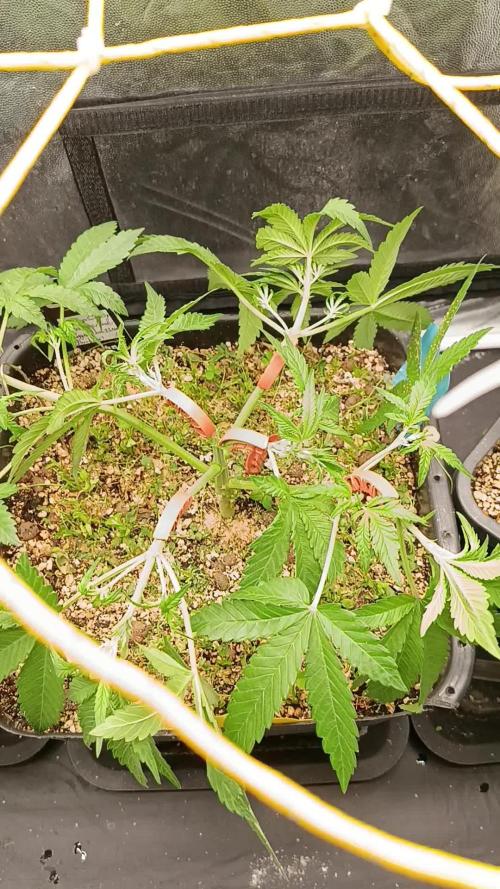The Grow Awards 2026 🏆 





























Likes
52
Share


@The_Good_Twin
Follow
14 Jul 2021
The plant is still looking lovely, and her buds look wonderful. I’m continuing with the flush of properly pH’ed water chilled to 46.3F. My initial pH was 7.7, so I added 15 gtts (1.5ml) of pH DOWN which adjusted the pH to 6.2. I’d like it to be higher, but working with pH DOWN is so much harder than pH UP! The TDS going in was 75 ppm. Our heat wave is still going strong, and the temperature in the tent was 88F with humidity at 44%. The runoff pH was 5.3, and TDS runoff was 1897 ppm. That’s a reduction of 410 ppm from the watering on the 12th. At this rate it’ll be next week or later till I can harvest. If it does, I may end up harvesting sooner and curing longer. 🤷♂️ I’ll have to wait and hope I guess.
16 Jul 2021
I’m continuing with the flush today, and I’m beginning to think I should start flushing more often, yet I don’t want to damage the plant. At this stage of growth I don’t know if overwatering is as detrimental as it is to a younger, less developed plant. I want to harvest it before she gets too far along in her trichome development. She was clearly ready when I checked them on July 10th, and I don’t want her to get much farther along. Today I’m giving water at tap temps because at this point I don’t believe it matters. Everything I’m deciding to do is purely by instinct and trial and error. I feel like a researcher working on viable material that has a known outcome in general, but getting to the final stage (harvest) is detrimental in how the individual works the issues, or problems, and prepares for a desired outcome. Only each strain is different, and learning to adjust to those differences is the learning process. I never knew that growing weed could be so much fun, or as stressful! But I dig it!
Today she received a gallon of water with an initial pH of 7.7. I added pH down 5 gtts (.5ml), which adjusted the pH to 6.4. TDS going in was 91 ppm. Runoff pH was 5.9, and TDS runoff was 1407 ppm. Temperature in the tent was 84F, and humidity was 60%. There was a 390 ppm reduction from the last watering 2 days ago. At least it’s moving in the right direction.
18 Jul 2021
The flush is going well as you’ll be able to see once I post my numbers a little later in this note. Her buds are still looking awesome, and she still looks healthy for the most part. Her leaves on the fan side still look dried up on the edges, but not completely dead. Since it’s happening on both of my plants in the same location, the cause was easy to surmise as I’ve noted it before. I’ll be ready for harvest in about a week or less, and then her tent mate will be left alone for a while. Today she was given a gallon of water chilled to 57.2F with an initial pH of 8.0. I added 8 gtts (>1ml) of pH DOWN in 2 separate increments to adjust it to pH 6.7. The TDS going in was 80 ppm. The runoff pH was 6.1, and TDS runoff was 784 ppm. That’s a reduction of 623 ppm since the last flushing/watering. So I’m down into the 3 digit realm now, so hopefully it won’t be too much longer! She smells like blueberry muffins! I’m not even kidding a little. Like blueberry muffins. I’ve never seen a better named strain ever!
20 Jul 2021
Flushing continues in my grow room today. I swear this part takes so long and is so frustrating. I only have myself to blame, but all is still good. She is ready for harvest, but I still need to finish this up first. The TDS runoff shows that the level is still dropping, just not as fast as I’d like it to be. Today I chilled a gallon of water to 57.7F, then got her ready to give my baby. The initial pH was 8.1, so I added pH DOWN 10 gtts (1ml), which adjusted the pH to 6.8. The TDS going in was 74 ppm. Runoff today: pH 6.3, and TDS 658 ppm. Our heat wave is still kicking hard, so the tent temperature was 88F, and humidity was 49%. I’m still hoping to harvest in a few days to a week from now. It all just depends on the flush. I didn’t bother with any pics today. Mainly because the lights went off as I was finishing up and figured there aren’t any changes from 2 days ago to bother. However, today ends a week, so the next will be a fresh week, so I’ll take pics then.
Likes
24
Share


@ValleoGrow
Follow
So this was the first time doing lst, and the first time i trained Them was def to early, so i might have decressed my yield pretty much but, theyre doing really fine besides the lack of budsides, and i Think still 4 weeks of flower to get faat, and soo beautiful Colors showing already😍😍
Likes
9
Share


@HUMO_Cultiva
Follow
We are happy of the results, but in the next batch we will be put 8 plantas and AC
Likes
13
Share


@Chubbs
Follow
420Fastbuds-Week9
Strain:FBT2311
What up grow fam. Weekly update for these gorgeous girls. They're definitely getting close to being done and getting the chop. I did a defoliation this week to allow the light down to the lower bud sites. All in all Happy Growing.
Likes
15
Share


@Wenz004
Follow
So diese Woche kam das umtopfen der ursprünglichen Balkonpflanze #1 in living soil...morgen ab Sonntag wird geflippt auf 12h...schon ganz aufgeregt...meine erste Photo...hab Befürchtung das der Platz im 150x150cm Zelt nicht reichen wird.
Von der ursprünglichen Balkonpflanze #2...die ausgewildert wurde (guerilla) hab ich noch keine aktuellen Bilder...aber kommen noch...in der Woche 9 gibts welche...nicht groß...aber sensationele Farbe und Glanz
Likes
1
Share


@lumiloop
Follow
Noticed I was feeding too much nitrogen into flowering so cut back on that in the last couple weeks. Also noticed runoff TDS creeping up so I'm feeding each plant with slightly lower nutes at 1.5 gal a day w/ about 25% runoff. Currently about 700 going in with 1400 coming out. Nothing much other than that, just trying to keep them happy.
Likes
8
Share


@GhostByte
Follow
24/3 Harvested as soon as i saw a few amber thrichs here and there. I dont like too much cbn.
I learned i need to defoliate more next run, the bottom buds seem kind off airy because of lack of light penetration. I used to grow with stronger HPS lights before and now getting into the LED game. A little switch for me but ill get the hang of it.
I dont have a hanging scale, ill put the dry weight here on my next post in a couple weeks.
1/4 shes dry and started to trim. Gotta clean the scissors every bud 😄 onto trim jail and curing. Will test a popcorn bud tonight
2/4 everything is trimmed and in grove bags. Froze the trim overnight and the popcorn buds and made dry sift hash this morning.
Likes
7
Share


@Adam22
Follow
The plant on the right got chopped down the hairs were 90% dark brown while left was fully white last week when it got taken down it had only one day flush. This plant I will flush for a week and see which is better. It has decent size buds all the way to the bottom but this one growing still doesn't have as many crystals as the harvested plant which was definitely cut down way to early 😕 shame it must have forced to finish early from shock when I snapped a main branch clean off. This plant I will flush with plain filtered water for 7 days and even if it doesn't have as much crystals as the other plant, the bud size is 2x-3x the size of the plant that was cut down last week so I hope they will look a lot better size wise after they shrink when they are cut down and dried. I have also noticed some medium sized fan leads turning from green into a beautiful dark purple colour over the last 2-3 days slowly and it's spreading to other leaves the buds on this plant are also purple bits it's hard to see on here but looking sweet so far I have uploaded pic of the frost one which has been drying for a week now
Likes
19
Share


@Bread_n_Buds
Follow
Despite having had some problems during the growth 99% for my demerits and faults and 1% for my fault the child has recovered great and in the end she looks very very beautiful and fit. The flowers smelled no good because in that room there is the smell that I would like to hear on my deathbed to imagine flying who knows where.
Music of the Week - Gerorge Clinton to get crazy bud.
Radio Nula from Slovenia the rest of the time.
Light >> Marshydro SP3000 AT 90% of Power
Tent >> Marshydro 120x60x180
Check IG >> https://www.instagram.com/marshydro_aliexpress2/
Buy >> marshydroled.aliexpress.com
https://2fast4buds.com/
Likes
4
Share


@PolezGardn
Follow
Week 2 flower, the ladies show that they are female! they are doing well so far, the Chemdog is getting very big :D they get 2 liters of water every 3 days
Likes
5
Share


@Major
Follow
I made a big mistake when editing my new week I erased my first weeks 😤😤 but I don't have to complain about everything is fine for my plants 🤗😂😂
Likes
2
Share


@BjomaBudz
Follow
Heute gab es zusätzlich BioBizz zu den Biotabs – aber nach meinem eigenen Schema.
Je 2 ml von:
Bio Grow, Top Max, Bio Bloom
Je 3 ml von:
Fish Mix, ActiVera, Bio Heaven
Außerdem:
0,6 ml CalMag.
Da die zwei Autos gerade anfangen, sich zu strecken und ich das Biotabs-Starterkit verwende (bei dem ich etwa 15 % unter den Vorgaben dosiere), passe ich auch die BioBizz-Düngung entsprechend nach unten an. Da alles organisch ist und es immer etwa 2–4 Tage dauert, bis der Dünger wirkt, beginne ich minimal mit dem Blütenschema und nutze gleichzeitig noch das Veggie-Schema. Sobald die Blüte richtig losgeht, werde ich mein BioBizz-Schema entsprechend anpassen.
Likes
43
Share


@Indica_Jones
Follow
DFIe Buds entwickeln sich sehr gut :) diese Woche war relativ enbtspannt da ich hauptsächlich nur Gießen musste und das ein oder andere Sonnensegel entfernt habe damit ausreichend licht auf alle Buds fällt allerdings bin ich damit leider noch nicht fertig :)
Likes
10
Share


@Cr4zyElite
Follow
Sixth Week / 13.06.24 - 19.06.24
Week 6 continued with smooth growth and development! 🌿 Focused on optimizing light exposure to each bud site using the SCROG technique, ensuring all buds are getting the attention they need. ☀️
The pistils are looking healthy and vibrant, showing promising signs of robust flowering. 🌼
Excitingly, Apollo F1 is already starting to develop its first trichomes, a sign that things are progressing well. ✨
Everything is on track, and the plants are thriving in their environment. 🚀
Likes
5
Share


@GirlGoneWeed
Follow
Clones got transplanted into my organic recycled soil in solo cups and under the dome.
Under 300w LED QB dimmed at 50%
Watering with tap water. My live soil is packed with nutrient's and minerals so there’s no need to add nutes for now.




























